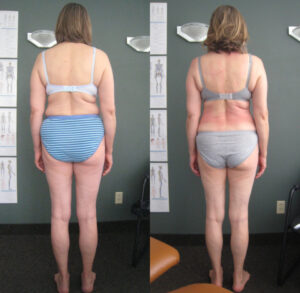
Correcting posture to alleviate chronic aches and pains, and improve overall health and self-image. Imagine a body in perfect alignment, every muscle, bone, organ, ligament and connective tissue working in concert just as they were designed to. A body truly in balance.
That is the goal of structural integration. To restore proper posture, flexibility and pain-free mobility. Yet few of us enjoy such freedom. Each day we suffer a number of stressors that affect our movement: improperly designed seating, hunching over computer screens, tilting our necks to answer phones. The list is endless. Perhaps an injury or illness in the past has put further strain on the body. These negative activities and the pain and strain they cause are ingrained in “muscle memory” and can become habitual behaviors. We literally “forget” what a body in balance feels like. Correcting posture is not just about alleviating aches and pains. It has a significant impact on our health and how we think and feel. A slouched forward posture can show as signs of sadness or loss of confidence while physically compressing around heart and lungs, restricting breathing and circulation.

Poor posture alters your biomechanics, causing undue stress and strain on your muscle and joints. Most of us already know this. Holding ourselves in one position too long, creates tension and a need to stretch when we get up. But problems in posture can sneak up on you. A sprained ankle can cause you to limp and shift your weight to the other leg. This now shifts all of the joints above, creates a twist or tilt in your pelvis which effects the connection with the spine, which can shift how your head sits on your shoulders. Now your muscles have to work harder against gravity as they cannot rely on your bone structure for support. It becomes like driving your car out of alignment – You can still drive your car, but you are going to wear-out your tires more quickly. Poor biomechanics can cause increased pressure in joints, overtime resulting in more serious issues like arthritis or disc herniations. Basically, if your posture is off you are not as strong as you can be.
Posture has an impact on our overall physical and mental health. Slouching compresses the lungs and restricts the volume of your breath. Overtime, this has a negative impact on your cardiovascular health. They refer to long periods of sitting to “the new smoking” for all the negative health issues it causes. New studies in neurology are showing that how your body moves has an impact on how your brains functions. Sitting in an inward posture, as our kids do while texting or playing computer games, only stimulates the primitive brain, which is self-focused. Whereas reaching out and away from your body stimulates the frontal lobe which promotes thoughts about others and community. Some research even shows that the further forward your head is from your posture (often our posture as we sit at computers), the higher your risk of dementia later in life. Changing the way your body moves can change the way your mind thinks.
Emotions can change our posture too. A child who is shy or frightened may “sink” into their chest like a physical attempt to hide or not be seen. As they grow, the emotions may change, but the posture has become a habit that they are stuck with. Or a time of excessive stress, causing the shoulders to elevate and roll inward (protect the neck protect the heart), can become a strong holding pattern that over time presents as neck shoulder pain, headaches, TMJ, etc. Long sustained tension on your posture cases fascia to contract and thicken, like applying a layer of duct tape over the area of stress. Structural integration can help break these subconscious patterns, releasing the fascial restriction that bind you to them and allow your true self to shine (also read Myofascial Release). Changing your physiology, changes your psychology. Try it yourself – sit in a chair slouching, now sit up straight. Can you feel how in the latter posture you feel stronger and have more energy?
Structural integration is quite different from traditional massage therapy as it focuses on treating fascia, the body’s connective tissue. (See Myofascial Release for more specific information about fascia and this technique.) Through a series of soft tissue manipulations targeting the body’s entire system of fascia/connective tissue, a trained structural integrator restores freedom of movement by treating the whole body as a complex, interconnected system not a series of individual localized problems. Structural integration takes a “big picture” view of your body and posture, what’s working and what isn’t, and assists in restoring everything back into proper alignment. By studying your posture, the therapist may discover that your chronic shoulder problem really isn’t a shoulder problem at all. Perhaps an old knee injury is putting pressure on the body’s web of fascia causing pain to be reflected in the shoulder. One area of the body tries to compensate for damage elsewhere. In this case, treating the shoulder will never solve the problem as it is simply a symptom of a more extensive problem elsewhere.
Each structural integration session begins with a postural analysis to identify problem areas. As some techniques are performed seated or standing, the client wears stretchy shorts, a bathing suit or underwear (depending upon the client’s comfort) throughout the treatments. No lotions or oils are applied to the body. Structural integration is usually offered as a course of 12 treatments with each session targeting specific areas of the body and building on the work completed in previous appointments. However, it can also be offered as a mini 3 series or individual sessions, with the therapist focusing on the areas that they feel will be most beneficial for your needs. Each treatment plan is unique because each patient is unique.
Structural integration was originally developed by Ida Rolf in the 1920s and the technique was called Rolfing. Today, the core concepts of structural integration are practiced and marketed under a variety of names. Rolfing, Neuromuscular Integration and Structural Alignment (NISA) and Kinesis Myofascial Integration (KMI) are just some of the major disciplines taught to healthcare practitioners who earn certification from each respective school. These names are copyrighted and can only be used by certified graduates of the respective programs. Our Structural Integration therapists are certified graduates of Kinesis Myofascial Integration (KMI), a school developed and run by Thomas Myers, who trained with Ida Rolf and taught anatomy at the Rolf Institute for many years.
